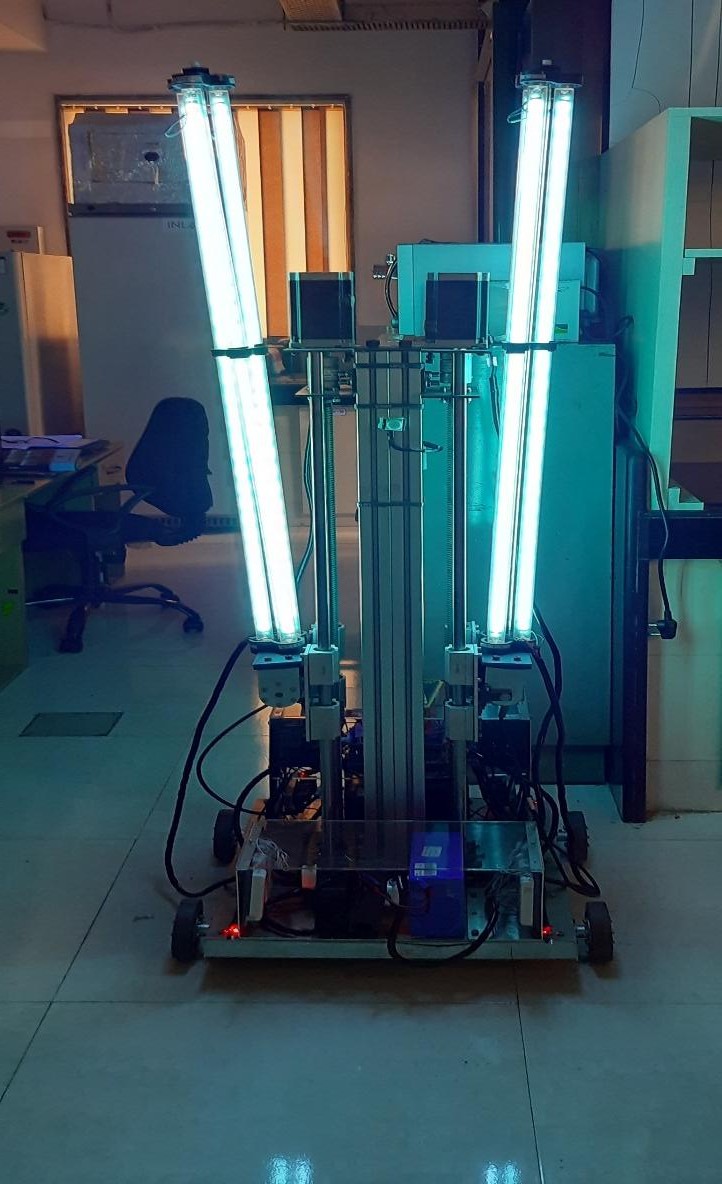This invention describes a robotic disinfection system designed to effectively disinfect various surfaces using ultraviolet (UV) light. The system includes disinfection arms equipped with UV lamps that emit germicidal UV light. The arm mounting assembly allows the disinfection arms to rotate, while the arm sliding assembly enables the arms to slide vertically for better coverage. A central support structure provides stability and support to the sliding assemblies, and a movable platform supports all assemblies, allowing the entire system to be moved from one location to another. This robotic disinfection system is designed to navigate and disinfect complex surfaces and areas, ensuring that UV light reaches all parts effectively.
Disinfecting public and shared spaces—such as hospitals, transport systems, and theatres—is critical to prevent the spread of infectious microbes. While UV germicidal technology is effective, conventional systems struggle with inconsistent coverage due to line-of-sight limitations and a rapid drop in UV intensity with distance. This results in either underexposed or overtreatment of surfaces, compromising safety and increasing energy usage. Moreover, most current devices are static, lack mobility, and cannot be controlled remotely, making them unsuitable for dynamic or complex environments.
- Rotational and Translational Motion capabilities of the robotic arms ensures that UV light can reach all surfaces, including complex, elevated, or shadowed areas.
- The robot can adjust the speed and direction of the disinfection arms based on the dimensions and characteristics of the target surface, ensuring precise and effective UV dosing.
- Motion detection turns off the UV lamp and arms’ movement to prevent accidental UV exposure to humans and animals.
- Remote control of the system through wireless communication allows operators to manage the process without being physically present, thereby avoiding UV exposure.
UVC lamp assembly of each disinfection arm consists of three 36-watt conventional germicidal UVC lamps (LP mercury lamp, Philips, TUV 36W SLV/6), having 15W UVC (254 nm) power.A 24V, 24Ah, LiFePO4 battery is used to power up the arm rotation assembly of both disinfection arms. Another 24V, 24Ah, LiFePO4 battery along with DC-DC step-up modules (# SZ-BT07CCV-D1), is used to power up the sliding assembly for both disinfection arms. An 11.1V, 8Ah, LiPo battery is used to power all DC motor drivers. The UVC lamp assembly of each disinfection arm is powered with a 12.8V, 30Ah LiFePO4 battery along with two 300W power inverters.
This disinfection robot additionally features multiple passive infrared sensors (PIR) for motion detection and IR sensors for obstacle identification. Locomotion speed, arm rotation speed as well as arm sliding speed can be adjusted as per the required disinfection applications.
The system is an early prototype and is validated in relevant environment.
5
This invention provides option of chemical-free disinfection and hence environment friendly. By automating the disinfection process, the robotic disinfection system reduces the reliance on manual labour, minimizing the risk of exposure to harmful pathogens for cleaning staff. This can lead to improved workplace safety standards and better overall health outcomes for workers.
Furthermore, the system's ability to efficiently disinfect various environments helps prevent the spread of infectious diseases, which is very important especially in preventing COVID-19 and other future pandemic situations.
Healthcare, Public Transportation, Hospitality
Healthcare settings such as hospitals and clinics to ensure thorough disinfection of patient rooms, operating theaters and other contaminated areas. This can also be used for disinfection in public transportation systems or any public venues like airports, cinemas, hotels, where it can disinfect large areas quickly and effectively, ensuring safety of large groups of people and minimise risk of pathogen transmission in high-traffic environments.
Geography of IP
Type of IP
202121050239
401487


